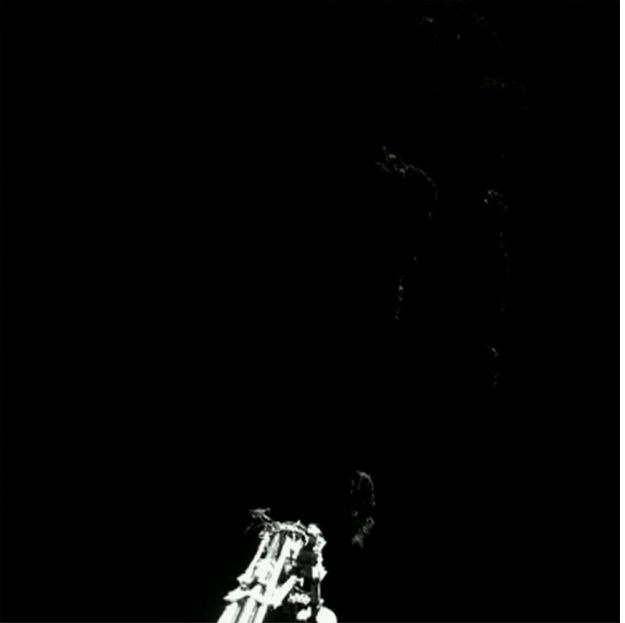QUOTE (surbiton @ Jan 13 2015, 11:08 PM)

One thing I seem to recall from the 2-3 days when signals were being received from Philae before the battery ran out. This was an observation by someone at ESA that on the second or third "comet day", Philae came on exactly "on time"as was expected.
Since some of you guys have already modeled 67P's rotation and are also aware of Rosetta's position at any given time as well, I would have thought a line could be drawn on the comet which would be just "visible" to Rosetta at those moments. We would then know that Philae must lie at or near that line. . . .
I just took a glance at the view from Rosetta towards 67P during the ~2 days after Philae's landing, using STK & the SPICE data.
A few observations:
- ESA positioned Rosetta so that it would be directly overhead of the Philae planned landing spot. It remained close to that viewpoint during the entire two days, though it moved quite a bit further away from 67P on Nov 13th. Philae's planned landing spot is quite close to the equator, so that means that planned landing spot passes directly under Rosetta once per rotation.
- If Philae is where ESA seems to think it is (the "blue triangle" from some of the graphics ESA folks have released, which is far side of the 'head' crater, probably in a cleft on that hillside) then interestingly enough, in that spot Philae will become visible to Rosetta at almost the exact same time as the planned landing site. In other words, the start of the radio communication window with Rosetta would be almost exactly the same from this spot as with the planned landing spot. This is true even though the two sites are around a kilometer distant from each other and in quite different topographies. This is something of a coincidence and possible what initial led some of the ESA folks to conclude that they must have ended up quite close to their planned landing site.
- Both the planned landing site and the presumed final resting site are roughly on the top of the head of 67P and not too far from each other. So it is quite true that either way radio contact would start/end at *about* the same time and local features in other location could pretty precisely mimic the other location (or nearly any other location on/around the top of the head).
- If Philae were *not* in a cleft, but more on top of one of the peaks, or even one a high spot on the far hillside (vs in the bottom of a cleft in the far hillside) it would like have come into radar contact before the landing site would. The time difference in that case would be about 30 minutes.
- Where there probably was a difference in radio contact time in the presumed final vs planned landing spot, is in the *end* of the radio transmission window. Since the presumed final resting spot of Philae is (generally) on the east side of the crater rim mountains, and the comet rotates towards the eastward, in the presumed final resting spot, Philae would lose radio contact maybe 90 minutes before it would if on the flat area of the planned landing site.
- However, there are areas very near the planned landing site that would duplicate that radio profile! For instance, if it had landed just on the east side of one of several crater walls within 200-300 meters of the planned landing site, it would also cut off the radio window about 60-120 minutes earlier than if on the perfectly flat location.
We don't know the radio start and end times precisely (ESA hasn't publicly released them, that I know of) but even presuming ESA did, it probably only told them that Philae was indeed somewhere on the head, and also that local topography was somewhat affecting the radio communications window. They might have been able to deduce from that, that Philae was likely on more of an east-facing slope (or, more precisely, that some obstacle was just to the west of Philae blocking radio communications).
Also, interestingly, it looks like to me that if ESA had known Philae's exact location it probably could have positioned Rosetta nearer the south pole and had potentially a much larger communications windows with Philae. If Rosetta was positioned high over the south pole, continuous radio communications might even have been possible. But if Rosetta were positioned, say, halfway between the equator and south pole, you'd quite certainly have a noticeably longer communications window than what they did have.
(From that position, Rosetta would also have had a continuous view of the dark side of the comet--not very interesting from the visual point of view!)
Whether and how this different positioning of Rosetta for a longer communications window would have worked would depend on the details of Philae's final position, which of course we don't know even now. Whether it would have been a good idea is another question yet. But I do think it would have been possible.



